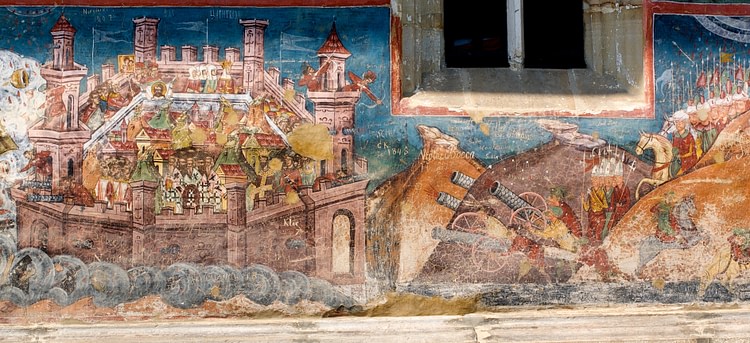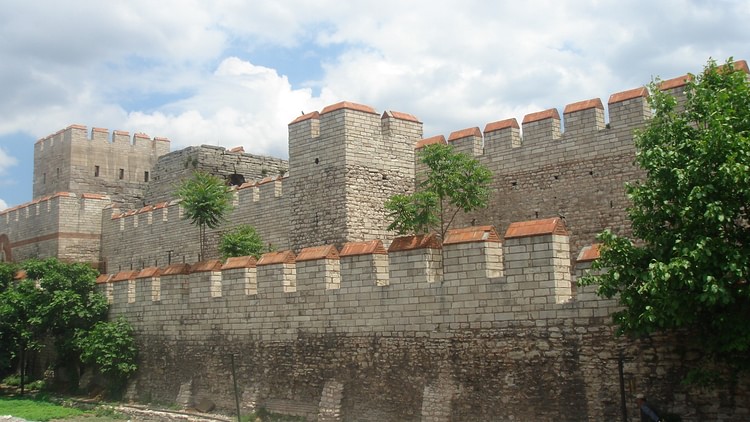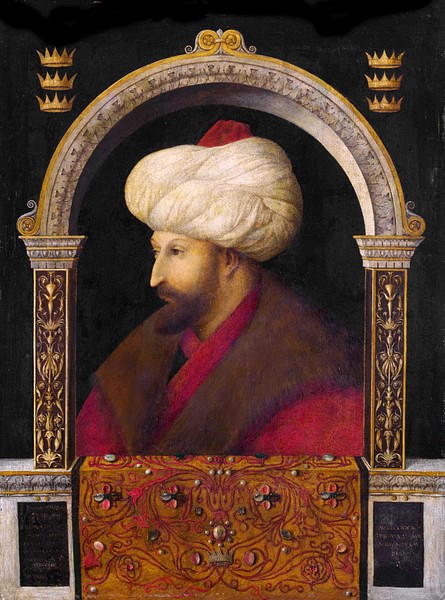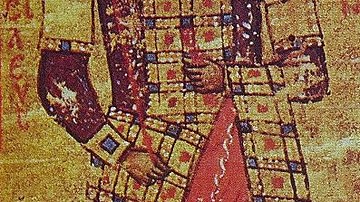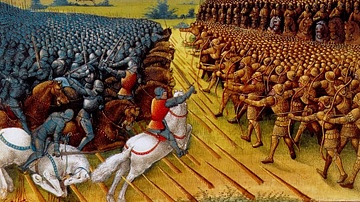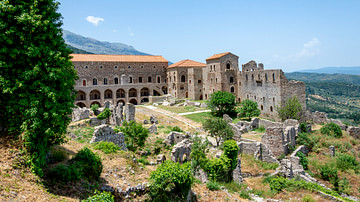The city of Constantinople (modern Istanbul) was founded by Roman emperor Constantine I in 324 CE and it acted as the capital of the Eastern Roman Empire, or Byzantine Empire as it has later become known, for well over 1,000 years. Although the city suffered many attacks, prolonged sieges, internal rebellions, and even a period of occupation in the 13th century CE by the Fourth Crusaders, its legendary defences were the most formidable in both the ancient and medieval worlds. It could not, though, resist the mighty cannons of the Ottoman Sultan Mehmed II, and Constantinople, jewel and bastion of Christendom, was conquered, smashed, and looted on Tuesday, 29 May 1453 CE.
An Impregnable Fortress
Constantinople had withstood many sieges and attacks over the centuries, notably by the Arabs between 674 and 678 CE and again between 717 and 718 CE. The great Bulgar Khans Krum (r. 802-814 CE) and Symeon (r. 893-927 CE) both attempted to attack the Byzantine capital, as did the Rus (descendants of Vikings based around Kiev) in 860 CE, 941 CE, and 1043 CE, but all failed. Another major siege was instigated by the usurper Thomas the Slav between 821 and 823 CE. All of these attacks were unsuccessful thanks to the city's location by the sea, its naval fleet, and the secret weapon of Greek Fire (a highly inflammable liquid), and, most importantly of all, the protection of the massive Theodosian Walls.
The city's celebrated walls were a triple row of fortifications built during the reign of Theodosius II (408-450 CE) which protected the land side of the peninsula occupied by the city. They extended across the peninsula from the shores of the Sea of Marmara to the Golden Horn, eventually being fully completed in 439 CE and stretching some 6.5 kilometres. Attackers first faced a 20-metre wide and 7-metre deep ditch which could be flooded with water fed from pipes when required. Behind that was an outer wall which had a patrol track to oversee the moat. Behind this was a second wall which had regular towers and an interior terrace so as to provide a firing platform to shoot down on any enemy forces attacking the moat and first wall. Then, behind that wall was a third, much more massive, inner wall. This final defence was almost 5 metres thick, 12 metres high, and presented to the enemy 96 projecting towers. Each tower was placed around 70 metres distant from another and reached a height of 20 metres. The towers, either square or octagonal in form, could hold up to three artillery machines. The towers were so placed on the middle wall so as not to block the firing possibilities from the towers of the inner wall. The distance between the outer ditch and inner wall was 60 metres while the height difference was 30 metres.
To take Constantinople, an army would, then, need to attack by both land and sea, but all attempts failed no matter who tried and no matter what weapons and siege engines they launched at the city. In short, Constantinople, with the greatest defences in the medieval world, was impregnable. Well, not quite. After 800 years of resisting all comers, the city's defences were finally breached by the knights of the Fourth Crusade in 1204 CE, although the attackers got in through a carelessly left-open door and not because the fortifications themselves had failed in their purpose. Repaired and rebuilt by Michael VIII (r. 1261-1282 CE) in 1260 CE, the city remained the most difficult military nut to crack in the world, but this reputation did not in any way deter the ever-more ambitious Ottomans.
The Ottoman Empire
The Ottoman Empire had begun as a small Turkish emirate founded by Osman in Eskishehir (western Asia Minor) in the late 13th century CE, but by the early 14th century CE, it had already expanded into Thrace. With their capital at Adrianople, further captures included Thessaloniki and Serbia. In 1396 CE, at Nikopolis on the Danube, an Ottoman army defeated a Crusader army. Constantinople was the next target as Byzantium teetered on the brink of collapse and became no more than a vassal state within the Ottoman Empire. The city was attacked in 1394 CE and 1422 CE but still managed to resist. Another Crusader army was defeated in 1444 CE at Varna near the Black Sea coast. Then the new Sultan, Mehmed II (r. 1451-1481 CE), after extensive preparations such as building, extending, and occupying fortresses along the Bosporus, notably at Rumeli Hisar and Anadolu in 1452 CE, moved to finally sweep away the Byzantines and their capital.
The Defenders
The crushing of the Crusader army at Varna in 1444 CE meant that the Byzantines were now on their own. No significant help could be expected from the West where the Popes were already unimpressed with the Byzantine's unwillingness to form a union of the Church and accept their supremacy. The Venetians did send a paltry two ships and 800 men in April 1453 CE, Genoa promised another ship, and even the Pope later promised five armed ships, but the Ottomans had by then already blockaded Constantinople. The people of the city could only stock up on food and arms and hope their defences would save them yet again. According to the 15th-century CE Greek historian and eyewitness Georges Sphrantzes, the defending army was composed of fewer than 5,000 men, not a sufficient number to adequately cover the length of the city's walls, some 19 km in total. Worse still, the once great Byzantine navy now consisted of a mere 26 ships, and most of those belonged to the Italian colonists of the city. The Byzantines were hopelessly outnumbered in men, ships, and weapons.
It seemed that only divine intervention could save them now, but in the many previous sieges over centuries gone by, it was believed that just such intervention had saved the city; perhaps history would be repeated. Then again, there were also ominous tales of impending doom: prophesies that proclaimed the fall of Constantinople when the emperor was called Constantine (a good number were, of course) and there was an eclipse of the moon - which there was in the days before the siege of 1453 CE.
The Byzantine emperor at the time of the attack was Constantine XI (r. 1449-1453 CE), and he took personal charge of the defence along with such notable military figures as Loukas Notaras, the Kantakouzenos brothers, Nikephoros Palaiologos, and the Genoese siege expert Giovanni Giustiniani. The Byzantines had catapults and Greek Fire, the highly inflammable liquid which could be sprayed under pressure from ships or walls to torch an enemy, but the technology of warfare had moved on and the Theodosian Walls were about to get their sternest ever test.
The Attackers
Mehmed II had one thing that previous besiegers of Constantinople had lacked: cannons. And they were big ones. The Byzantines had actually had first option on the cannons as they had been offered them by their inventor, the Hungarian engineer named Urban, but Constantine could not meet his asking price. Urban then peddled his expertise to the Sultan, and Mehmed showed more interest and offered him four times what he was asking. These fearsome weapons were put to good use in November 1452 CE when a Venetian ship, disobeying a ban on traffic, was blown out of the water as it sailed down the Bosphorus. The captain of the vessel survived but was captured, decapitated, and then impaled on a stake. It was an ominous sign of things to come.
According to Georges Sphrantzes, the Ottoman army numbered 200,000 men, but modern historians prefer a more realistic figure of 60-80,000. When the army assembled at the city walls of Constantinople on 2 April 1453 CE, the Byzantines got their first glimpse of Mehmed's cannons. The largest was 9 metres long with a gaping mouth one metre across. Already tested, it could fire a ball weighing 500 kilos over 1.5 km. So mammoth was this cannon that it took an awfully long time to load and cool it so that it could only be fired seven times a day. Still, the Ottomans had plenty of smaller cannon, each capable of firing over 100 times a day.
On 5 April, Mehmed sent a demand for immediate surrender to the Byzantine emperor but received no reply. On 6 April the attack began. The Theodosian Walls were relentlessly blasted, chunk by chunk, into rubble. The defenders could do no more than fire back with their own smaller cannons by day, hold off the attackers where the cannons had punched the biggest holes, and try and repair those gaps each night as best they could, using rocks, barrels, and anything else they could get their hands on. The resulting rubble piles actually absorbed the cannon shot better than fixed walls but, eventually, one of the infantry assaults would surely get through.
A Fight For Survival
The onslaught went on for six weeks but there was some effective resistance. The Ottoman attack on the boom which blocked the city's harbour was repelled, as were several direct assaults on the Land Walls. On 20 April, miraculously, three Genoese ships sent by the Pope and a ship carrying vital grain sent by Alphonso of Aragon managed to break through the Ottoman naval blockade and reach the defenders. Mehmed, infuriated, then got around the harbour boom by building a railed road via which 70 of his ships, loaded onto carts pulled by oxen, could be launched into the waters of the Golden Horn. The Ottomans then built a pontoon and fixed cannons to it so that they could now attack any part of the city from the sea side, not just the land. The defenders now struggled to station men where they were needed, especially along the structurally weaker sea walls.
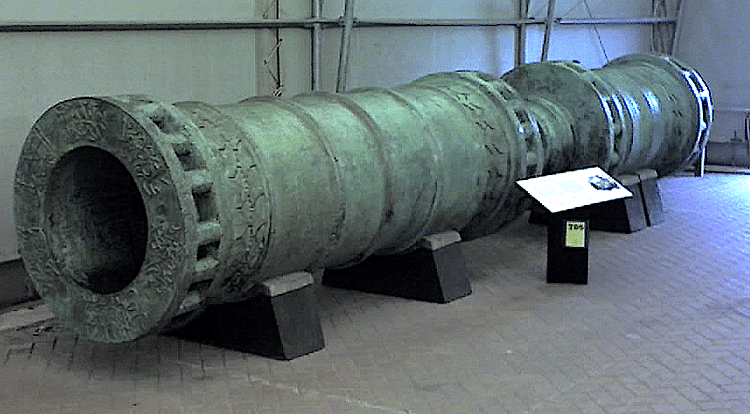
Time was running out for the city but, then, a reprieve came from an unexpected quarter. Back in Asia Minor, Mehmed faced several revolts as his subjects became unruly while their Sultan and his army were abroad. For this reason, Mehmed offered Constantine a deal: pay tribute and he would withdraw. The emperor refused, and Mehmed gave the news to his men that now, when the city fell, as surely it would, they could plunder whatever they wished from one of the richest cities in the world.
Mehmed launched a massive go-for-broke, throw-everything-at-them assault at dawn on 29 May. First to be sent in after the usual cannon barrage were the second-rate troops, then a second wave was launched with better-armed troops, and, finally, a third wave attacked the walls, this time composed of the Janissaries - the well-trained and highly determined elite of Mehmed's army. It was during this third wave that disaster struck the Byzantines who by now were forced to employ women and children to defend the walls. Some fool had left the small Kerkoporta gate in the Land Walls open and the Janissaries did not hesitate in using it. They climbed to the top of the wall and raised the Ottoman flag, then they worked their way around to the main gate and allowed their comrades to flood into the city.
Destruction
Chaos now ensued with some of the defenders maintaining their discipline and meeting the enemy while others rushed back to their homes to defend their own families. It is at this point that Constantine was killed in the action, most likely near the Gate of St. Romanos, although, as he had discarded any indications of his status to avoid his body being used as a trophy, his demise is not known for certain. The emperor could have fled the city days before but he chose to stay with his people, and a legend soon grew up that he had not died at all but, instead, he had been magically encased in marble and buried beneath the city which he would, one day, return to rule again.
Meanwhile, the rape, pillage, and destruction began. Many of the city's inhabitants committed suicide rather than be subject to the horrors of capture and slavery. Perhaps 4,000 were killed outright, and over 50,000 were shipped off as slaves. Many sought refuge in churches and barricaded themselves in, including inside the Hagia Sophia, but these were obvious targets for their treasures, and after they were looted for their gems and precious metals, the buildings and their priceless icons were smashed, the cowering captives butchered. Uncountable art treasures were lost, books were burned, and anything with a Christian message was hacked to pieces, including frescoes and mosaics.
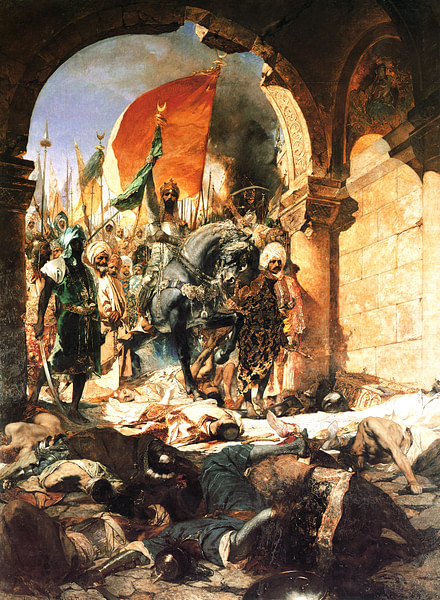
In the afternoon, Mehmed entered the city himself, called an end to the pillaging and declared that the Hagia Sophia church be immediately converted into a mosque. It was a powerful statement that the city's role as a bastion of Christianity for twelve centuries was now over. Mehmed then rounded up the most important survivors from the city's nobility and executed them.
Aftermath
Constantinople was made the new Ottoman capital, the massive Golden Gate of the Theodosian Walls was made part of the castle treasury of Mehmed, while the Christian community was permitted to survive, guided by the bishop Gennadeios II. What was left of the old Byzantine empire was absorbed into Ottoman territory following the conquest of Mistra in 1460 CE and Trebizond in 1461 CE. Meanwhile, Mehmed, aged only 21 and now known as "the Conqueror", settled in for a long reign and another 28 years as Sultan. Byzantine culture would survive, especially in the arts and architecture, but the fall of Constantinople was, nevertheless, a momentous episode of world history, the end of the old Roman Empire and the last surviving link between the medieval and ancient worlds. As the historian J. J. Norwich notes,
That is why five and a half centuries later, throughout the Greek world, Tuesday is still believed to be the unluckiest day of the week; why the Turkish flag still depicts not a crescent but a waning moon, reminding us that the moon was in its last quarter when Constantinople finally fell. (383)
